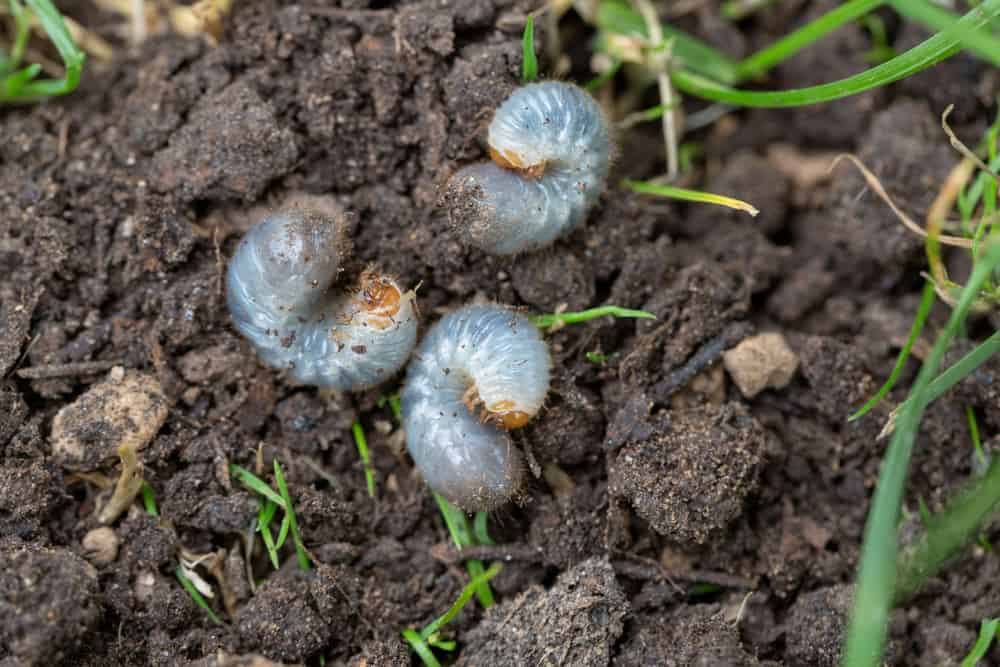Our lawns are our pride and joy for many of us, an extension of our beloved homes. We spend hours cultivating and caring for them, but disaster can strike no matter our best efforts! Grubs can find their way in and threaten to undo all our hard work.
Grubs can be pesky; the larvae settle in the soil, feasting on the organic matter, devouring anything in their way, including your grassroots. Before you know it, your lawn is at their mercy, dying and turning brown in areas they are eating.

Grubs love your lawn, making it increasingly unhealthy until they are satisfied. What are your options here? Surrender your lawn? Move? Scorch the earth and start again?
Before you jump to these conclusions, we have a way out! We have the best treatment for grubs! Keep reading to find out how to banish them from your lawn!
Table of Contents
What is the best treatment for grubs?
There is a range of treatments that you can use for grubs, ranging from preventative measures, insecticides, and natural therapies. Finding the right one for you doesn’t need to be difficult; we will outline them now for you!
Generally speaking, an insecticide is your best treatment option. Carbaryl or trichlorfon are the best options to use in the spring or fall. These chemicals will kill up to 80% of the grubs when applied in the early fall. Any later in the year, and the insecticide won’t work efficiently; timing is critical with insecticides.
It can also take a while for results to be seen; you can expect to wait up to 4 weeks, so be patient! It’s best to water these insecticides immediately, too, as this will promote positive results.
If chemical insecticides don’t sound like the method for you, we have three more treatment options below!
Preventative Treatments
If grubs have not already infested your lawn, preventative treatment is the best option for you. It will eliminate or significantly reduce the risk of grubs.
Consistent treatment has better success than curative methods. Look for products that contain the following: imidacloprid, thiamethoxam, chlorantraniliprole, or clothianidin. These products will work on newly hatched or small grubs usually present in July.
It is best to apply preventative treatments during June or July, reducing grubs anywhere from 75-100%, especially if you water them down immediately with roughly half to one inch of water.
Natural Treatments
Most grub treatments you see will involve chemicals, but natural treatments do exist! Any natural therapies should be carried out during September to ensure a high success rate. Be warned, though, natural remedies require a lot of work.
Using nematodes, apply them to moist or wet soils and irrigate immediately. Be sure to apply these when the sun isn’t out to avoid the rays killing the nematodes. If the nematodes are successful at entering the soil, they will get to the grubs and remove them for you!
Pesticides
Pesticides are another option and best used on sunny, dry days where the rain won’t undo all your hard work. Remember to wear protective clothing, gloves, and eyewear when using pesticides to ensure your safety at all times.
When using a pesticide, water it with roughly half an inch of water to promote drainage. Ensure that children and pets are kept away from the lawn until the pesticides dry. The extra precautions do put some people off using pesticides.
How do you know if you have grubs in your lawn?
You can check for grubs by lifting a piece of turf. If the patch rolls up like a carpet, or the grass has no roots when you lift it out, you have grubs. You can also tell if you have grubs if you notice any irregularly shaped dead patches on a well-irrigated lawn appear.
You can expect to see the signs of this during the late summer or early fall when the baby grubs start to get to work! These tests are easy to carry out and will identify any grubs in your lawn.
Is it too late to treat for grubs?
Not necessarily. The best time to treat for grubs in the late summer or early fall when you are likely to remove the young grubs and stop repopulation.
You also have a short window of time in the early springtime, before the grubs get too big and begin to pupate. It can be tricky in this second window to achieve an effective treatment for grubs.
If you have missed these windows, though, it does not mean you need to surrender your lawn to the grubs! There are plenty of products that work right through until September, eradicating your grubs.
It is worth noting that preventative treatments will go a long way in reducing and preventing grubs from entering your lawn. These treatments will work all year round. If you have not used these, treat your grubs in the late summer to stop the next generation of grubs from wreaking havoc on your lawn!
